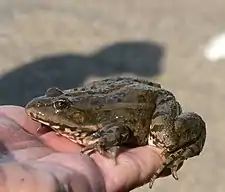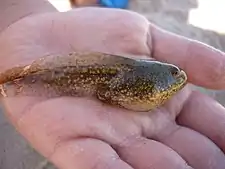Marsh frog
The marsh frog (Pelophylax ridibundus) is a species of water frog native to Europe and parts of Asia. They occur in a large part of Europe starting from western France and spreading out into the Middle East and about a quarter into Russia.[3] There are also isolated populations in Saudi Arabia and the Russian Far East, along with some introduced populations in the United Kingdom and other places.[4] These frogs are very lenient in their habitats, and are able to inhabit a majority of different types of water bodies.[3] The marsh frog is the largest type of frog in most of its range, with males growing to a size around 97.86 mm (3.85 in) SVL and females 102.36 mm (4.03 in) SVL.[5] Tadpoles can reach up to 186 mm (7.32 in) in length,[3] but this usually occurs in places with long winters where the tadpole has time to grow. Marsh frogs hibernate during the winter either underwater or in burrows, and are able to use the magnetic field of Earth to locate breeding ponds.[6]
| Marsh frog | |
|---|---|
 | |
| Scientific classification | |
| Kingdom: | Animalia |
| Phylum: | Chordata |
| Class: | Amphibia |
| Order: | Anura |
| Family: | Ranidae |
| Genus: | Pelophylax |
| Species: | P. ridibundus |
| Binomial name | |
| Pelophylax ridibundus (Pallas, 1771) | |
| Synonyms | |
|
Rana ridibunda Pallas, 1771[2] | |

There is a large variation in colour and pattern, ranging from dark green to brown or grey, sometimes with some lighter green lines; a lighter line on the back is generally present. The frog will usually be darker colored in early spring to absorb heat more efficiently.
Marsh frogs have a large head that is able to devour a wide variety of prey, mostly arthropods and other invertebrates. In an analysis of 53 adults in Thrace, Diptera made up 42.62% and Coleoptera 21.84% of their diet.[7] These frogs have been found to climb onto water buffalo so they could eat the flies attracted to it, hinting at a possible mutualistic relationship.[8] As tadpoles, they eat a wide range of organic matter including algae, detritus, decaying plants, and dead animals.[3]

Hybridogenesis
There are known three hybridogenetic hybrids of the marsh frog:
- edible frog Pelophylax kl. esculentus (usually genotype RL):
pool frog P. lessonae (LL) × P. ridibundus (RR)[9][10] - Graf's hybrid frog Pelophylax kl. grafi (PR):
Perez's frog P. perezi (PP) × P. ridibundus (RR) or
Perez's frog P. perezi (PP) × edible frog P. kl. esculentus (RE)
(it is unclear which one crossing was the primary hybridization)[10] - Italian edible frog Pelophylax kl. hispanicus (RB):
Italian pool frog P. bergeri (BB) × P. ridibundus (RR)
Their populations are maintained however through other crossings by hybridogenesis.[10] In places where they were introduced, marsh frogs may pose a threat to the native Pelophylax by diluting the gene pool, but there is evidence that although they may hybridize they do not affect the overall population that greatly.[4][11]
References
- Kuzmin, Sergius; Tarkhnishvili, David; Ishchenko, Vladimir; Dujsebayeva, Tatjana; Tuniyev, Boris; Papenfuss, Theodore; Beebee, Trevor; Ugurtas, Ismail H.; Sparreboom, Max; Rastegar-Pouyani, Nasrullah; Disi, Ahmad Mohammed Mousa; Anderson, Steven; Denoël, Mathieu; Andreone, Franco (2009). "Pelophylax ridibundus". IUCN Red List of Threatened Species. 2009: e.T58705A11825745. doi:10.2305/IUCN.UK.2009.RLTS.T58705A11825745.en.
- Frost, Darrel R. (2013). "Pelophylax ridibundus (Pallas, 1771)". Amphibian Species of the World 5.6, an Online Reference. American Museum of Natural History. Retrieved 24 July 2013.
- "Pelophylax ridibundus Marsh Frog". AmphibiaWeb.
- Leuenberger, Julien; Gander, Antoine; Schmidt, Benedikt R.; Perrin, Nicolas (20 February 2014). "Are invasive marsh frogs (Pelophylax ridibundus) replacing the native P. lessonae/P. esculentus hybridogenetic complex in Western Europe? Genetic evidence from a field study". Conservation Genetics. 15 (4): 869–878. doi:10.1007/s10592-014-0585-0. S2CID 17246330.
- Erismis, Ugur (7 March 2010). "Abundance, demography and population structure of Pelophylax ridibundus (Anura: Ranidae) in 26-August National Park (Turkey)" (PDF). North-Western Journal of Zoology. 7 (1): 5–16.
- Shakhparonov, Ogurtsov, Vladimir, Sergey (November 2016). "Marsh frogs, Pelophylax ridibundus, determine migratory direction by magnetic field". Journal of Comparative Physiology. 203 (1): 35–43. doi:10.1007/s00359-016-1132-x. PMID 27885506. S2CID 6361418 – via ResearchGate.
- Çiçek, Mermer, Kerim, A. (January 2007). "Food composition of the marsh frog, Rana ridibunda Pallas, 1771, in Thrace". Turkish Journal of Zoology. 31 (1): 83–90 – via ResearchGate.
- "A possible mutualistic interaction between vertebrates: frogs use water buffaloes as a foraging place". Acta Herpetologica. 12 (1): 113–116. July 2017 – via ResearchGate.
- Berger, L. (1970). "Some characteristics of the crossess within Rana esculenta complex in postlarval development". Ann. Zool. 27: 374–416.
- Holsbeek, G.; Jooris, R. (2010). "Potential impact of genome exclusion by alien species in the hybridogenetic water frogs (Pelophylax esculentus complex)" (PDF). Biol Invasions. Springer Netherlands. 12: 1–13. doi:10.1007/s10530-009-9427-2. ISSN 1387-3547. S2CID 23535815. Retrieved 2015-06-19.
- "A record of alien Pelophylax species and widespread mitochondrial DNA transfer in Kaliningradskaya Oblast' (the Baltic coast, Russia)" (PDF). BioInvasions Records. 9. June 2020 – via Regional Euro-Asian Biological Invasions Centre.
External links
| Wikimedia Commons has media related to Pelophylax ridibundus. |
- Listen to Pelophylax ridibundus call sound
